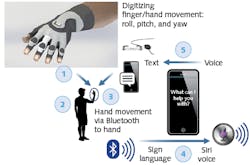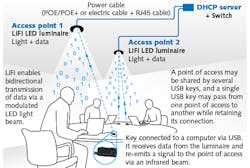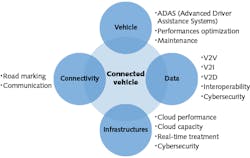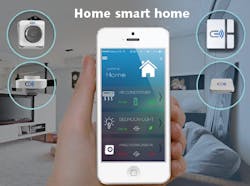Photonics Applied: The Internet of Things: Photonics—a fundamental enabler for the Internet of Things
According to Wikipedia, the Internet of Things (IoT) is the “inter-networking of physical devices, vehicles (also referred to as ‘connected devices’ and ‘smart devices’), buildings, and other items embedded with electronics, software, sensors, actuators, and network connectivity which enable these objects to collect and exchange data.”
And although some individuals are not keen to have a talking refrigerator, it is important to not lose sight of the fact that networked environments can be powerful. Lola Courtillat, project chief of business and innovation at the Opticsvalley (www.opticsvalley.org), a partner and coordinator of European Framework/Photonics21 programs and facilitator of international technological exchanges, looks back to a 1999 presentation to Procter & Gamble by Kevin Ashton, cofounder and executive director of the Auto-ID Center at the Massachusetts Institute of Technology (MIT; Cambridge, MA), who said, “If we had computers that knew everything there was to know about things—using data they gathered without any help from us—we would be able to track and count everything and greatly reduce waste, loss, and cost.”
“Less than 20 years after, devices are able to interact with each other and share data better than we do,” Courtillat adds (see Fig. 1). “Enabling Machine to Machine communication (M2M), they send commands to each other, access the available networks—whether mobile, wired, or wireless—and change our old habits of interaction with every element of our environment.”
If you consider the use of imaging sensors, optics, fiber optics, positioning equipment, and software in IoT applications, you don’t have to look very far to understand the critical role these components play in expanding the photonics IoT universe. Perhaps the best way to understand how photonics enables IoT is to look at some of the most significant photonics IoT applications: communications, transportation, environmental monitoring, and smart homes, factories, and gadgets.
Communications
As a fast-growing business sector with a global market of around $550 billion in 2015 and projected to reach more than $750 billion by 2020, photonics has been defined as one of the six Key Enabling Technologies (KETs) of Europe by the European Commission.1-3 A large fraction of those billions is represented by the lasers and optical fibers that light our communications infrastructure.
“Charles K. Kao was awarded the Nobel Prize in Physics ‘for groundbreaking achievements [since the 1960s] concerning the transmission of light in fibers for optical communication,’” Courtillat says, “ensuring a permanent role for optics in nearly every communications-intensive IoT application and redefining our understanding of connectivity.”4
“We all know that the high-bandwidth optical communications networks that power the Internet rely on optical fibers and powerful laser diode sources,” Courtillat says. “But critical to many IoT applications are smaller, more private networks enabled by light-emitting diodes (LEDs). Historically intended to supplant traditional, low-efficiency (5–10%) incandescent and halogen lighting sources, LEDs offer ultralow energy consumption, long life, and a small size that promises more than simple illumination.” Courtillat notes that Benjamin Azoulay, director of the French Syndicat de l’éclairage until 2017 and CEO of Oledcomm (http://ledcomm.com), emphasizes that if LEDs continue their tremendous rise in terms of energy performance, the next step is of course connectivity via LiFi or Li-Fi (Light Fidelity) systems, or luminaires that communicate with other equipment (see Fig. 2).5
FIGURE 2. Lucibel has developed the first lighting fixture equipped with LiFi technology; a special LED lighting fixture exchanges data with a computer, making Internet access possible through two-way broadband data transfer active within the light beam only and guaranteeing total data transmission protection. (Image credit: Lucibel; see https://goo.gl/EHhP6w)
In LiFi, signals are carried by the modulation of the light emerging from LEDs. Researchers at the Fraunhofer Henrich Hertz Institute (HHI) in Germany have transmitted data at 3 Gbit/s using conventional LED light bulbs in a laboratory setting. In a real-world setting (at a trade fair), the same system was capable of 500 Mbit/s.6
LiFi communications turns every light bulb into a network connection for areas with lots of radio-frequency noise such as conventions or trade fairs, and is ideal for locations where radio frequencies are prohibited because of interference with sensitive electronics, such as on planes and in hospitals. Courtillat adds that researchers presenting at the first Global LiFi Congress (www.lificongress.com) in Paris in February 2018 argued that LiFi networks are more secure than standard wireless connections because they prevent piggybacking—the unauthorized access of wireless LAN, sometimes referred to as Wi-Fi squatting. Furthermore, LiFi eliminates neighboring network interference common with Wi-Fi routers.
Beyond LiFi, the fifth generation of wireless communications technology (5G) will be crucial to successful implementation of numerous IoT applications.7 With lower latency (1 ms), higher bandwidth, and improved ability to connect devices, 5G was front and center at the Consumer Electronics Show of 2018. In an article entitled “CES 2018 is where you’ll start caring about 5G,” Asha Keddy, who heads up Intel’s efforts on IoT, connected devices, and next-generation networks, said that in a 5G future, “We’re not just going to be connecting 6 or 7 billion people, we’ll be connecting tens of billions of things. It will be phones, lights, cars, buildings, appliances, you name it.”
Transportation
Optical communications are critical for transportation or mobile environments. And beyond optical fiber and LED/laser sources, photonics is also having a tremendous impact on automotive IoT applications through the networking of light detection and ranging (lidar), time-of-flight, and visual instrumentation being incorporated for both advanced driver assistance systems (ADAS) and fully autonomous vehicles.
“Capitalizing on the knowledge from the field of VANET [Vehicular Ad-Hoc Networks)] and exploiting the new technologies of the Internet of Things, an emerging domain, the ‘Internet of Vehicles or IoV’, is beginning to take shape around V2X [Vehicle-to-Everything] ubiquitous communications,” Courtillat says (see Fig. 3).8,9 “Passive or active photonic sensing technologies—mainly cameras and lidar—enable object/obstacle detection, collision avoidance, identification/classification and tracking, blind spot detection, lane keeping, adaptive cruise control, parking assistance, and finally, full autonomy. Without photonics, these connectivity-dependent mobility applications would not exist.”
FIGURE 3. Shown is one representation of the environment of the connected vehicle. (Image credit: Paul Stefanut/Opticsvalley)
Perhaps the ultimate in autonomous vehicles is not necessarily in personal transportation, but in agriculture. Imagine tractors, plows, and harvesting machines fitted with lidar for autonomous driving, laser ranging devices to plow fields evenly for proper water distribution, and sensors to note soil moisture, crop health, and pesticide levels. Of course, as an interconnected IoT application, all of these sensors could send data to the cloud for analysis and, in turn, inform the machines which fields require attention and if human intervention is needed.
Environmental monitoring
The same lidar principles that enable autonomous vehicles are also being implemented in IoT networks that monitor our environment. The National Oceanic and Atmospheric Administration (NOAA) specifies that lidar data supports activities such as inundation and storm surge modeling, hydrodynamic modeling, shoreline mapping, emergency responses, hydrographic surveying, and coastal vulnerability analysis, allowing scientists to generate more accurate shoreline maps and precise three-dimensional information about both natural and manmade environments.10
Many companies are cashing in on the environmental monitoring IoT craze by making a case for the particular communications networks that they sell. For example, Link Labs (Annapolis, MD), which sells low-power, wide-area-network (LPWAN) technologies, has published information on eight top use cases for environmental monitoring, including monitoring of air, water, soil, forests, natural disasters, fisheries, snowfall levels, and datacenter environments for temperature and humidity. Of course, LPWAN is touted as the best solution for these applications because of its low cost, long battery life (5–10 years), long range (500 m to 10 km), and satellite backhaul ability.
Another LPWAN provider is WAVIoT (Moscow, Russia), who advertises their IoT environmental monitoring solutions as eliminating “the headaches of traditional remote monitoring: point-to-point wireless radios, satellite links, VPNs, servers, storage, and software.” Not only does WAVIoT supply the LPWAN networking equipment, cloud user interface systems, and telecom back-end management systems, but it also sells IoT hardware including smart water-flow and gas sensors, electricity meters, soil moisture indicators, and thermal meters.
A quick Google search on ‘IoT environmental monitoring’ brings up numerous companies like Link Labs, WAVIoT, and other companies selling both hardware and software solutions, including HyQuest Solutions (Aachen, Germany), which specializes in marine, meteorological, and air quality applications, and Valarm (California), a software company that lists numerous customer IoT applications it has served, including remote monitoring of water levees, ground water usage, levels of chemicals in industrial tanks, bridge expansion joints, and air pollution levels using a variety of electronic and optical sensors such as distributed optical fibers, position and imaging sensors, and spectrometers.
Smart homes, offices, and gadgets
The IoT Online Store at www.iotonlinestore.com claims that there will be 50 billion devices connected to the Internet by 2020, with most of those gadgets serving the smart home and wearables markets—considered the top two most popular IoT markets, according to a web analytics ranking.
Concerning wearables, our recent article on wearable photonics describes a variety of wearable illumination and sensor devices, but the power of IoT is the interconnectedness of these devices. On a personal level, a pulse oximeter can help a jogger in Central Park understand their fitness level, but imagine if pulse oximeter readings for hundreds of joggers throughout New York City could be monitored in a central database and compared to typical readings, alerting health authorities to potential pollution problems or even respiratory alarms such as a terrorist gas attack if those levels were to suddenly drop. And no longer does one need to imagine how deaf/mute individuals could communicate through a smartphone using hand gestures: fiber-optic sensors embedded in the DigiGlove from the Fraunhofer Institute for Telecommunications (Fraunhofer HHI; Berlin, Germany) have that IoT application covered (see Fig. 4).
FIGURE 4. The DigiGlove data glove uses fiber-optic sensors (with fiber Bragg gratings or FBGs) and photonic components for 3D motion capture to enable deaf/mute people to communicate via a smartphone. A compact, battery-operated interrogation unit converts digital sign-language gestures to language that is sent over Bluetooth to a mobile phone for display or conversion to voice using Siri or similar software; a second person can answer the smartphone directly or have the text displayed into smart glasses. (Image credit: Wolfgang Schade/Fraunhofer HHI)
On the home front, products that incorporate photonic devices enter the marketplace on a daily basis. The Ring Doorbell uses an HD camera with night vision to let you answer the door from anywhere, day or night, on your smartphone. Momit Thermostats have an LCD screen and allow you to control your home’s temperature remotely from your smartphone, tablet, or laptop. Zipato Smart Home Control uses cameras and Wi-Fi to control all of your electronic devices and monitor your home through live video and mobile alerts in the case of security intrusions. And Cielo WiGle (Redmond, WA) controls all your smart home functions with smartphone software (see Fig. 5).
FIGURE 5. The smart home connects all your devices to maximize functionality and security, assuming your data networks are not hackable. (Image credit: Cielo WiGle)
Although the original intention of IoT was the networking of devices to reduce waste, loss, and cost, not everyone is convinced of its utility. Cybersecurity is a critical concern and responsible for the growing interest in quantum information networks. And although a remote doorbell and secure package deliveries may sound attractive, we have already seen in the news how these systems can be hacked. The Late Late Show host James Corden recently commented on the smart refrigerator, saying that the incorporation of all those cameras would be a great tool to remind you that you need eggs. But he would rather not have the refrigerator communicating with his fitness monitor and locking the freezer door as he reaches for the ice cream.
REFERENCES
1. See https://goo.gl/UnYHwY.
2. See https://goo.gl/WbZh8i.
3. See https://goo.gl/scAyV4.
4. See https://goo.gl/kbxnBp.
5. See https://goo.gl/5Xm3a5.
6. See https://goo.gl/FPTyJq.
7. See https://goo.gl/qmB5ZP.
8. See https://goo.gl/fKUiLV.
9. See https://goo.gl/qWm4Ar.
10. See https://goo.gl/pce99D.

Gail Overton | Senior Editor (2004-2020)
Gail has more than 30 years of engineering, marketing, product management, and editorial experience in the photonics and optical communications industry. Before joining the staff at Laser Focus World in 2004, she held many product management and product marketing roles in the fiber-optics industry, most notably at Hughes (El Segundo, CA), GTE Labs (Waltham, MA), Corning (Corning, NY), Photon Kinetics (Beaverton, OR), and Newport Corporation (Irvine, CA). During her marketing career, Gail published articles in WDM Solutions and Sensors magazine and traveled internationally to conduct product and sales training. Gail received her BS degree in physics, with an emphasis in optics, from San Diego State University in San Diego, CA in May 1986.



